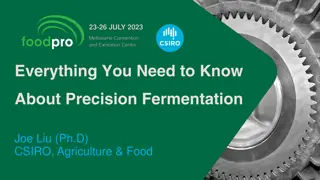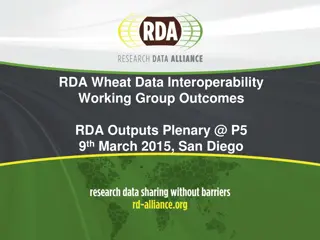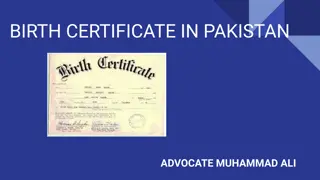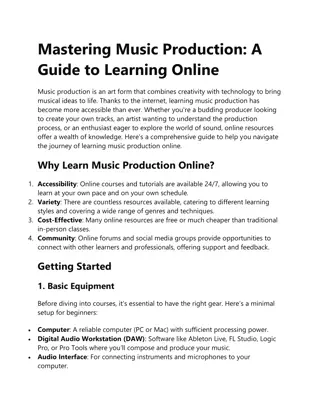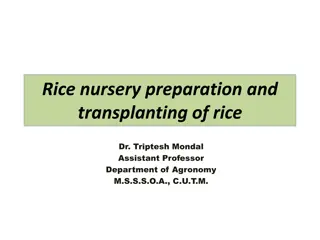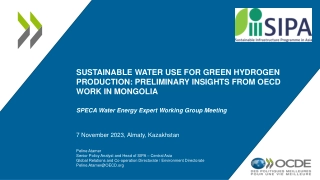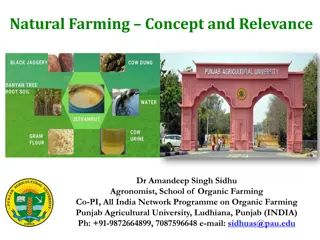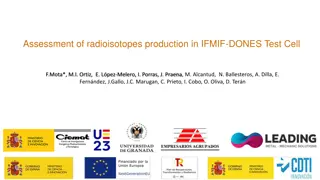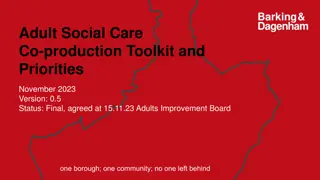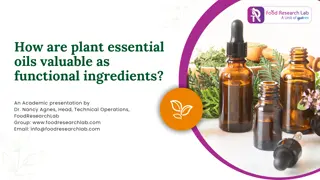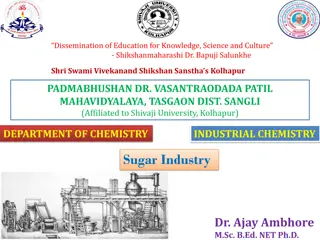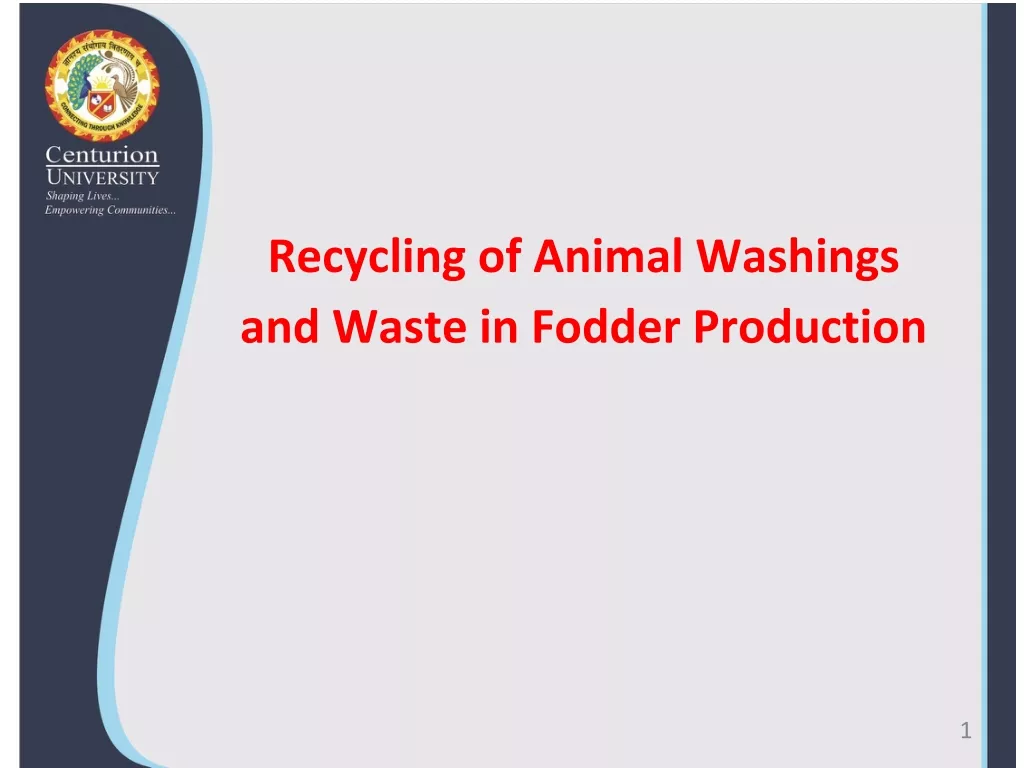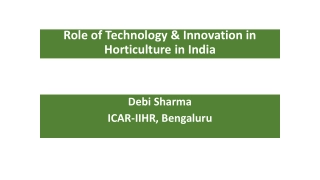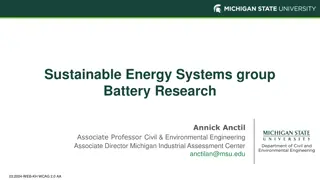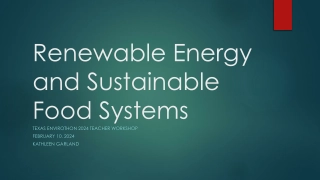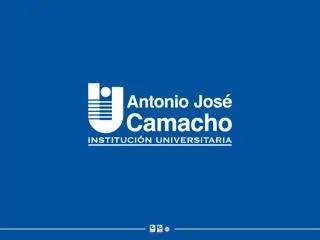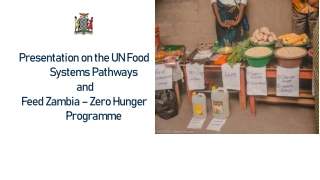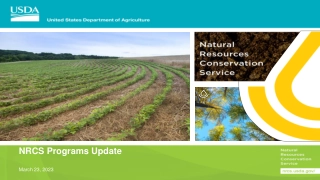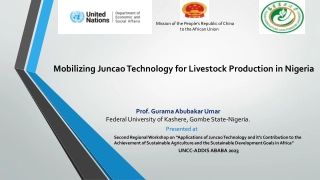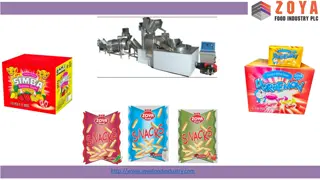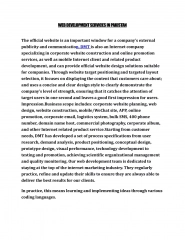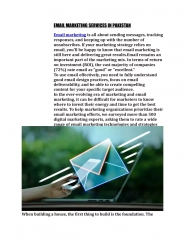Sustainable Rice Production in Pakistan: Challenges and Strategies
Pakistan's economy heavily relies on rice exports, with the country being a significant producer and exporter. However, challenges such as pesticide residues, major insect pests, and diseases threaten rice production. Key parameters for production include cultivation of improved varieties, pest management, and post-harvest practices. Preventing pesticide residues is crucial for maintaining export quality. Major insect pests and diseases like rice blast and sheath blight require effective management strategies to ensure sustainable rice production.
Sustainable Rice Production in Pakistan: Challenges and Strategies
PowerPoint presentation about 'Sustainable Rice Production in Pakistan: Challenges and Strategies'. This presentation describes the topic on Pakistan's economy heavily relies on rice exports, with the country being a significant producer and exporter. However, challenges such as pesticide residues, major insect pests, and diseases threaten rice production. Key parameters for production include cultivation of improved varieties, pest management, and post-harvest practices. Preventing pesticide residues is crucial for maintaining export quality. Major insect pests and diseases like rice blast and sheath blight require effective management strategies to ensure sustainable rice production.. Download this presentation absolutely free.
Presentation Transcript
PREVENTION OF PESTICIDE RESIDUES IN RICE EXPORTED FROM PAKISTAN DR. MUBARIK AHMED
IMPORTANCE OF RICE FOR PAKISTANS ECONOMY After wheat, rice is the second staple crop It is the second most exportable commodity, the first being cotton In 2021-2022 rice production equaled 9.32 million tons that declined to 7.32 million tons in 2022-2023. The decline was due to flooding in Sindh. Pakistan is the 10thlargest producer of rice and 4thlargest exporter of rice Pakistan is the largest exporter of rice in EU and export rice worth about 405 million USD
Major Pakistani Rice Importing Countries S. No Basmati Rice Non-Basmati Rice 1 UAE China 2 UK Kenya 3 Oman Ivory Coast 4 KSA Mozambique 5 Belgium Malaysia 6 Yemen Tanzania 7 Spain Indonesia 8 Azerbaijan Madagascar 9 Italy Senegal 10 Qatar Azerbaijan Source: Rice Exporters Association of Pakistan (REAP)
KEY PARAMETERS OF PRODUCTION i. Cultivation of improved varieties ii. Timely sowing and harvest iii.Weed control iv.Proper management of crop density v. Proper and timely application of fertilizer vi.Proper and timely management of water vii.Pest control viii.Proper and timely harvest and post-harvest management of paddy ix.Mechanization of cultivation practices
PEST MANAGEMENT IN RICE The management scheme should be SAFE for humans, animals and the environment. i. Insect management ii.Disease management (includes fungal, bacterial and viral diseases) iii.Weed management
MAJOR INSECT PESTS OF RICE i. Yellow Stem Borer ii.White Stem Borer iii.White-backed plant hopper iv.Rice leaf roller/folder v.Rice grasshopper vi.Small grasshopper
MINOR INSECT PESTS OF RICE i. Pink stem borer x. Cotton cutworm ii. Green leafhopper xi. Rice caseworm iii. Paddy white leafhopper xii. Rice skipper butterfly iv. Rice bug xiii. Short-horned grasshopper v. Green stink bug xiv. Mole cricket vi. Black paddy bug xv. Paddy soot fly vii. Rice army worm xvi. Rice gall midge viii. Paddy swarming caterpillar xvii. Rice thrips ix. Paddy cutworm
MAJOR DISEASES OF RICE i. Rice Blast ii. Rice Sheath Blight iii.Bacterial Leaf Blight iv.Rice False Smut v. Rice Bakanae Disease vi.Rice Brown Spots vii.Bacterial Sheath Brown Rot
REGISTERED PESTICIDES FOR RICE No. of Pesticides Marketed as Mixtures Pesticides Total Number Insecticides 50 28 Fungicides 36 18 Herbicides 47 28 Bio pesticides 2 - Molluscide 1 - Others 3 - Total 139 74
INTERCEPTION OF PAKISTAN RICE CONSIGNMENTS BY EU AND US Pesticides No. of Notifications Percentage Carbendazim (MBC) 51 31.7 Tebuconazole 31 19.2 Chlorpyrifos 17 10.6 Difenoconazole 17 10.6 Acetamiprid 15 9.3 Triazophos 11 6.8 Imidacloprid 9 5.6 Pirimiphos-Methyl 4 2.5 Isoprothiolane 2 1.2 Clothianidin 1 0.6 Profenofos 1 0.6 Thiamethoxam 1 0.6 Thiophanate-Methyl 1 0.6
AVAILABLE OPTIONS TO TACKLE THE PROBLEM Judiciary use of pesticides keeping in view the following To strictly follow the Pre-Harvest Intervals (PHI) of different pesticides and observe WHO Toxicity Classifications To avoid pesticides that were found to have exceeded MRLs Switching to IPM approach instead of totally relying on chemicals Not to apply pesticides that are not registered for rice Ensure proper dosage and calibration of spraying equipment
KEY PRINCIPLES FOR SELECTION OF PESTICIDES FOR PREVENTION / CONTROL OF PEST AND DISEASES Use pesticides that are registered for rice. Preharvest interval should be strictly followed. Pesticide should be safe considering WHO classification. Avoid pesticides that become a cause of rejection/interception.
WHO TOXICITY CLASSES Ia Extremely Hazardous Ib Highly Hazardous II Moderately Hazardous III Slightly Hazardous U Unlikely to Present Acute Hazard M Fumigant O Obsolete
PRE-HARVEST INTERVAL The preharvest interval (PHI) in agriculture refers to the minimum amount of time that must pass between the last application of a pesticide or other agricultural chemical and the harvest of the crop. It is a critical consideration to ensure that the produce is safe for human consumption and meets regulatory standards for pesticide residue levels. The PHI is determined by the pesticide manufacturer and is typically specified on the product label. It takes into account factors such as the chemical's degradation rate, absorption by the plant, and the potential health risks associated with consuming the crop shortly after pesticide application. Different pesticides have varying PHIs, which can range from a few days to several weeks or even months.
IMPORTANCE OF PRE HARVEST INTERVAL Farmers and growers must adhere to the specified PHI to comply with food safety regulations and minimize the risk of pesticide residues exceeding acceptable levels. Failure to observe the required interval may result in contaminated produce that is unsafe for consumption or may lead to regulatory penalties and market access restrictions.
PRE-HARVEST INTERVAL (PHI) OF INSECTICIDES REGISTERED FOR RICE Product Formulation PHI (D) Product Formulation 10%SC PHI (D) Product Formulation PHI (D) Chlorfenapyr+ Spinosad 13% SC (10.5% + 2.5%) & Tech. (Chlorfenapyr98% + Spinosad92%) 20% SC, 50% WDG 30% WDG (5% + 25%) & Tech. (98% + 98%) Abamectin + Methoxyfenozid e Abamectin + Thiamethoxam Monomehypo 5% G, 10% G, 3.6% G 30-40 14 7-10 Nitenpyram + Pymetrozine Permethrin 80% WDG (20% + 60%) 30 21 Clothianidin Clothianidin + Pymetrozine 12% SC (2% + 10%) 25 EC & 0.5 % Powder & 90% Tech. 14 21 10 Abamectin + Triazophos Buprofezin Buprofezin + Abamectin 20% EC (0.3% + 19.7%) 25% EC, 25% WP 15% WP (14.85% + 0.15%) Tech. (97% + 92%) 50% WP (15% + 35%) Dinotefuran + Pymetrozine 70% WG (35% + 35%) Pymetrozine Pymetrozine + Buprofezin Pymetrozine + Chlorpyrifos Pymetrozine + Dinotefuron Thiamethoxam 25% SC & 50% WG 50% WDG (17% + 33%) 11 30 14 10-12 14 Emamectin Benzoate + Indoxacarb Emamectin Benzoate + Lambda- Cyhalothrin 9% SC 30% WP (10% + 20%) 28 10-15 14 60% WG (20% + 40%) 12% WP (2% + 10%) & Tech. (Emamectin Benzoate 90% + Lambda-Cyhalothrin95%) 7-9 Buprofezin + Acephate Buprofezin + Isoprocarb Buprofezin + Metolcarb Buprofezin + Nitenpyram Carbosulfan 10 25% WG 7-10 10 25% WP (5% + 20%) Thiamethoxam + Buprofezin 24% WP (4% + 20%) 21 10-14 7-10 Fenobucarb Fenobucarb + Buprofezin Fipronil Lambda - Cyhalothrin Matrine Methoxyfenozide + Abamectin 25% EC & 97% Tech. 25% SE (20% + 5%) 25% WP (5% + 20%) 25 10-15 Thiamethoxam + Nitenpyram 50% WDG (30% + 20%) & Tech. (98% + 97%) 70% WG (60% + 10%) 7-14 25-35 5% SC 2.5% EC 14 7 20% EC (21.6% w/w), 20% ULV & 88% Tech. Thiocyclam Hydrogen Oxalate Flonicamid Imidacloprid 50% SP & 90% Tech. 30 7 0.3%AS 12 10% SC (8% + 2%) & Tech. (Methoxyfenozide98.5% + Abamectin 93%) Cartap Hydrochloride 4% G, 8% G, 95% SP 50% WG 3 7-10 25% WP 5% EC, 70% WG, 200 SC 30-40 7-14
PRE-HARVEST INTERVAL (PHI) OF FUNGICIDES REGISTERED FOR RICE Product Iprobenfos Isoprothiolane Formulation 50% EC & 40% EC 40%EC PHI (D) 21 Product Formulation 80% WDG PHI (D) Product Formulation 25% SC 32.5% SC (20% + 12.5%) PHI (D) 28 Sulphur (Thiovit Jet & Sulfex Gold) Azoxystrobin Azoxystrobin + Difenoconazole 10-20 14 Jingangmycin A + Tebuconazole 17% SC (12% + 5%) 5-7 Thifluzamide 24% SC & 98% Tech. 7-10 10 Azoxystrobin + Flutriafol 25% SC (125 g/l + 125 g/l) Thifluzamide + Thiophanate Methyl 50% SC (15% + 35%) & Tech. (96% + 95%) Kasugamy cin + Triey clazde 13% WP (3% + 10%) 30 10-15 7-10 Azoxystrobin + Propiconazole 32% SC (20% + 12%) 21 Kasugamycin Kasugamycin + Copper Oxychloride (Castle) 4% WP & 55% Tech. 50% WP (5% + 45%) & Tech. (Kasugamycin 65% + Copper Oxychloride 90%) Thifluzamide + Trifloxystrobin 40% SC (20% + 20%) & Tech. (95% + 97.5%) 28 10-13 21 Trifloxystrobin + Tebuconazole 75% WG (250 g/kg + 500 g/kg) Azoxystrobin + Tebuconazole 50% SC (20% w/v + 30% w/v) 35 9-13 Kasugamycin + Tricyclazole 13% WP (3% + 10%) & Tech. (Kasugamycin 55% + Tricyclazole 95%) Benzisothiazolino ne Carbendazin + Tebuconazole 3% ME 7-10 Triflumizole (Trifmine) 15% EC & 97% Tech. 7-10 11 60% WG & Tech. (98% + 97%) Kresoxim- Methyl + Fenoxanil Propiconazole (Tilt) 26% SC & 95% + 96% Tech Validamycin Validamycin + Epoxiconazole 10% SL & 60% TK 24% SC (16% + 8%) 11 7-10 21 8-15 250 EC & 94% Tech. Flutriafol + Tebuconazole 30% SC (75g/l + 225 g/l) Thiophanate Methyl 70 WP, 40% ULV 12 10-20 8-15
PRE-HARVEST INTERVAL (PHI) OF HERBICIDES REGISTERED FOR RICE Product Formulation PHI (D) Product Formulation 20% WP (15.5% + 4.5%) & Tech. (92% + 97%) PHI (D) Product Formulation 21% OD (12.5% + 3.5% + 5%) PHI (D) Pretilachlor + Oxadiargyl Propanil Propanil + Clomazone Pyrazosulfuron Ethyi + Bispyribac Sodium Pyrazosulfuron ethyi +Pretilachlor 32% WP (24% + 8%) & Tech. (98% + 96%) 360 EC & 97% Tech. 39%EC & Tech(Propanil 95% + Clomazone 96%) 30% WP 98% + 98% Tech Acetochlor + Bensulfuron Methyl 14 Cyhalofop Butyl + Penoxsulam + Bensulfuron-methyl 5-12 10-15 5-7 13 Bensulfuron Methyl + Acetochlor 16%KPP Fenoxaprop-p-ethyl + Penoxsulam 10% OD (4% + 6%) 5-12 5-7 10 Bensulfuron Methyl + Butachlor 30% WP Fluroxypyr Glyphosate Isopropylammonium 20% EC & 95% Tech. 41% SL 10 5-8 6.15%GR, 16.5% PP, 35% WP 11 5 Bensulfuron Methyl + Pretilachlor 30% EC (2% + 28%) Pyrazosulfuron Ethyl 10% WP & 10% WDG MCPA-Sodium + Carfentrazone Ethyl 70.5% WP (66.5% + 4%) 2-4 9 30 Pyrazosulfuron Ethyl + Carfentrazone Ethyl 30% WP (25% + 5%) Bensulfuron Methyl + Quinclorac 25% SC (3% + 22%) & Bensulfuron Methyl 96% Tech. & Quinclorac 96% Tech. Oxadiazon Oxadiazon + Butachlor Oxadiazon + Oxyfluorfen 12 EC, 25% EC 60% (10% + 50%) & Tech. (98% + 94%) 14% EC (10% + 4%) & Tech. (Oxadiazon 98% + Oxyfluorfen 97% ) 14% OD (1.5% + 2% + 10.5%) 25 10 30 3-5 Pyrazosulfuron Ethyl + Pretilachlor + Clomazone 38% WP (2% + 26% + 10%) 11 2-7 Bentazone Bispyribac Sodium 48% SL & 96% Tech. 2% SL, 10% SC, 20% WP, 40% SC 30% WDG (18% + 12%) & 30% WP (18% + 12%) 15-30 Pyrazosulfuron Ethyl + Quinclorac 50% WP (3% + 47%) & Pyrazosulfuron Ethyl 95% Tech. & Quinclorac 90% Tech. 15%WP & Tech(Pyrazosulfuron-ethyl 97% + Chyalofop-buptyl 98%) 24% OD (8% + 46%) & Tech. (Pyrazosulfuron-ethyl 98% + Oxadiargyl 96%) Penoxsulam + Bispyribac Sodium + Cyhalofop-Butyl 4-5 10-14 5-7 Bispyribac Sodium + Bensulfuron Methyl Pyrazosulfuron- ethyl + Cyhalofop- buptyl 7-10 Penoxsulam + Cyhalofop-Butyl Penoxsulam + Pyrazosulfuron-Ethyl 60% OD (10 g/l + 50 g/l) 4% OD (2% + 2%) 10 10-16 Butachlor 60% EC, 90% EC 60% EW 15 5-7 Pyrazosulfuron- ethyl + Oxadiargyl 10-14 Cinosulfuron Cyhalofop Butyl Cyhalofop Butyl + Bispyribac Sodium 10% WP & 92% Tech. 10% EW 16% OD (12% + 4%) 4-10 7 Pretilachlor Pretilachlor + Bensulfuron Methyl 2 G, 500 EC, 30% EC 35%WP & Tech (Pretilachlor 96% + Bensulfuron Methyl 96%) 13 Pyriftalid + Bensulfuron-Methyl 55.8% SC (36.6% + 18.48%) 11-15 13 1-2 Quinclorac 50% WP & 90% Tech. 9
Integrated Pest Management Approach To Control Important Insects and Diseases of Rice
WHAT IS INTEGRATED PEST MANAGEMENT? Integrated Pest Management is a broad-based and environment-friendly approach that integrates both chemical and non-chemical methods for economic control of pests and to keep it below economic injury level. It combines biological, cultural, physical and chemical control methods to minimize economic, health and environmental risks.
FIVE COMPONENTS OF INTEGRATED PEST MANAGEMENT 1. Taking no action 2. Use of cultural practice 3. Mechanical control 4. Biological control 5. Chemical control
MAJOR CHARACTERISTICS OF IPM 1. Pest identification 2. Monitoring pest number and damage 3. Develop guide line for action 4. Preventing pest population 5. Using one or more combination of techniques to include biological, cultural, physical, mechanical and chemical 6. Assessment
Integrated Management of Rice Blast (Magnaporthe oryzae) Cultural/Management Importance/Symptoms 1. Most destructive pathogen 2. Attacks all parts above ground 3. Eye shaped spots on leaves 4. Widely spread in Pakistan 5. Occurs in areas with low soil moisture and prolonged rains 6. Symptoms include node infection in banded pattern 1. 2. 3. 4. Cultivating susceptible varieties Remove stubbles at earliest Avoid late planting Soil should remain flooded 2-4 inch until plants are 6-8 inch tall Avoid excess nitrogen application Neem and Garlic extract are effective Field hygiene Weed management Adjusting planting time 5. 6. 7. 8. 9. Pesticides Exceeding MRL s Azoxystrobin + Difenoconazole (U + II) Difenoconazole + Validamycin ( II + U) Sulphur + Carbendazim (III + II) Thiophenate Methyl (U) Tricyclazole (II) Tricyclazole + Validamycin (II + U) Trifloxystrobin + Tebuconazole (U + II) Kasugamycin + Tricyclazole ( U + II ) ChemicalControl Azoxystrobin (U) Iprobenfos (II) Isoprothiolane (II) Kasugamycin (U) Kasugamycin + Oxychloride Kasugatity Chloride Hydrate Kresoxim-Methyl (III) Triflumizole Azoxystrobin + Flutriafal (U + II)
Integrated Management of Rice Sheath Blight (Rhizoctnia solani) Cultural/Management Importance/Symptoms 1. Soil borne fungi 2. Spores can survive 2 years under unfavorable conditions 3. Symptoms include formation of lesions leading to stem lodging 4. Lesions normally start from the leaf margins with wavy appearance 5. It has been reported in all parts of Pakistan 1. Keep field clean 2. Use disease resistant cultivars 3. Increases with overdosing of Nitrogen 4. Use of healthy seeds 5. Removal of stubble, straw and weeds 6. The disease is spread from the weeds in rice field Pesticides Exceeding MRL s ChemicalControl Azoxystrobin + Flutriafol (U + II) Azoxystrobin + Propiconazole (U + II) Iprobenfos (II) Kasugamycin (U) Kasugamycin + Methyl Fenoxanil Thifluzamide (U) Thifluzamide + Thiophanate Methyl (U + U) Thifluzamide + Trifloxystrobin (U + U) Validamycin (U) Azoxystrobin + Difenoconazole (U + II) Azoxystrobin + Tebuconazole (U + II) Tricyclazole + Validamycin (II + U) Trifloxystrobin + Tebuconazole (U + II)
Integrated Management of Bacterial Leaf Blight (Xanthomonas oryzae) Cultural/Management Importance/Symptoms 1. Lemon-colored irregular-shaped patches 2. Disease starts from the lower region and travels upwards 3. May result in complete drying of leaves (Kresek phase) 1. Use resistant varieties 2. Balanced nutrition 3. Good drainage 4. Field Hygiene 5. Keeping pH alkaline using bleach 6. Removing weeds 7. Plough under rice stubbles Pesticides Exceeding MRL s Chemical Control Benzisothiazolinone (U) Zinc thiazole (bactericide) Kresoxim Methyl + Fenoxilin ( III + U ) Jingangmycin + Tebuconazole (U + II)
Integrated Management of False Smut (Ustilaginoidea virens) Cultural/Management 1. Keep the field clean 2. Removal of plant debris after harvest 3. Adopt alternate wetting and drying instead of continuous flooding 4. Don t use excess nitrogen 5. Use certified seeds 6. Heat treatment of seeds before sowing 7. Use of resistant varieties 8. Planting rice earlier Importance/Symptoms 1. Causes chalkiness in grains and results in reduction in grain weight 2. Occurs in humid areas temperatures between 25-35 C 3. Velvety smut balls on spikelet 4. Infest early flowering stage and also when spikelet reach maturity 5. Does nor produce ergot Pesticides Exceeding MRL s ChemicalControl Carbendazim + Tebuconazole ( II + II) Jingangmycin + Tebuconazole (U + II)
Integrated Management of Bakanae Disease (Gibbella fujikuroi) Cultural/Management 1. Use clean seed 2. Separate lightweight seeds using saline water 3. Burn plant residues 4. Seed treatment Importance/Symptoms 1. Seed borne fungi 2. Infest after a month of planting 3. Infected plants are taller than the rest 4. On maturity infected plants tilt at the top Pesticides Exceeding MRL s ChemicalControl Fludioxonil (U) Fludioxonil + Metalaxyl M (U + II ) Thiophanate Methyl (U) Triflumizole (II) NIL
Integrated Management of Rice Brown Spots (Cochilobotus miyabeanus) Cultural/Management Importance/Symptoms 1. Characterized by brown spots in all parts of plant 2. Infest leaves, leaf sheath, panicle, branches, glumes and spikelets. 1. Treat seed with hot water 2. Seed treatment 3. Nitrogen deficiency increases the disease 4. Using resistant varieties Pesticides Exceeding MRL s ChemicalControl Tebuconazole + Flutriafal (II) Trifloxystrobin + Tebuconazole ( U + II) Difenoconazole + Propioconazole (II + II) Kasugamycin Hydrochloride Hydrate (U) Propiconazole (II) Sulphur ( III ) Triflumizole ( II)
Integrated Management of Bacterial Sheath Brown Rot (Pseudomonous fuscovaginae) Importance/Symptoms Cultural/Management 1. Clean the field 2. Adjust sowing time 3. Use fresh seedlings 4. Treat seed with hot water 5. Treat seed with fungicide 1. Causes rotting in sheath and grains 2. Occurs in high altitude, low temperature and high humidity 3. Seed borne 4. Symptoms occur on leaf sheath. 5. Discoloration at seedling stage with yellow or brown colour Pesticides Exceeding MRL s ChemicalControl Tebuconazole + Flutriafal (II) Trifloxystrobin + Tebuconazole ( U + II) Difenoconazole + Propioconazole (II + II) Kasugamycin Hydrochloride Hydrate (U) Propiconazole (II) Sulphur ( III ) Triflumizole ( II)
Integrated Management of Stem borrer infestation in rice (Scirpophaga incertulas, S. innotata, Chilo suppressalis, Sesamia inferens) Cultural/Management 1. Nursery should not be sown before 20th May and no later than first week of July 2. Avoid early or late sowing 3. Harvest close to ground 4. Destruction of stubbles and burning before February 5. Flooding of field in Dec-Jan for 5 days and then deep ploughing 6. Destruction of egg masses Importance/Symptoms 1. S. incertulas (YSB) and S. innotata (WSB) are major pests. The other two are minor. 2. Can be very destructive with yield loss varying between 5-90% 3. Hibernates in stubbles and becomes active from mid March to mid May 4. Infestation starts in nursery and thereafter maximizes Approved Pesticides Approved Pesticides Abamectin + Methoxyfenozide ( Ib + U) Benfuracarb ( II ) Chlorantraniliprole Fipronil ( II ) Fipronil + Cartap Hydrochloride ( II + II) Fipronil + Lambda-cyhalothrin ( II + II ) Flubendiamide ( III ) Lambda-cyhalothrin (II) Lambda-cyhalothrin + clofentezine (II + III) Monomehypo ( III ) Spinetoram Thiocyclam Hydrogen Oxalate ( II ) Pesticides Exceeding MRL s Abamectin + Thiamethoxam ( Ib + II) Abamectin + Triazophos ( Ib + Ib) Chlorantraniliprole + Thiamethoxam ( U + II ) Chlorpyrifos + Triazophos ( II + Ib) Triazophos ( Ib)
Integrated Management of Whitebacked Planthopper (Sogottella furcifera and S. catoptron) Cultural/Management 1. Fertilizer management as nitrogen influences host-insect interaction 2. Potassium deficiency increases the attack 3. Insect attack increases with stagnant water 4. Extremely high and low temperatures inhibit the attack Importance/Symptoms 1. They are long winged sucking insects. Adults are light brown to black. 2. Females are long and short winged. The short wing lays more eggs. 3. The forewings have a dark brown mark 4. Leads to yellowing (hopper burns), wilting, stunting with reduced grain production. Methoxyfenozide + Abamectin ( U + Ib ) Nitenpyram + Pymetrozine ( II + III ) Pymetrozine (III) Pymetrozine + Buprofezin (III + III) Pymetrozine + Dinotefuran (III + III) Abamectin + Thiamethoxam ( Ib + II ) Pesticides Exceeding MRLs Clothianidin ( II ) Imidacloprid ( II ) Imidacloprid + Beta-cyfluthrin ( II + Ib ) Pymetrozine + Chlorpyrifos (III + II) Thiamethoxam ( II ) Thiamethoxam + Buprofezin ( II + III) Thiamethoxam + Nitenpyram ( II + II ) Approved Pesticides Buprofezin (III) Buprofezin + Abamectin ( III + Ib ) Buprofezin + Acephate ( III + II ) Buprofezin + Isoprocarb ( III + II ) Buprofezin + Metolcarb ( III + II ) Buprofezin + Nitenpyram ( III + II ) Carbosulfan ( II ) Chlorofenapyr + Spinosad ( II + III ) Dinotefuran + Pymetrozine ( III + III ) Fenobucarb (II) Fenobucarb + Buprofezin ( II + III ) Flonicamid ( II )
Integrated Management of Rice Leaf Folder (Cnaphalocrocis medinalis) Cultural/Management 1. Heavy fertilizer, high humidity and weeds encourage multiplication of insect 2. Late sown crop more susceptible 3. Use of resistant varieties 4. Spraying pesticides is not recommended during early season 5. Follow crop rotation Importance/Symptoms 1. Leaffolder caterpillars fold rice leaves around themselves and attach leaf margins with leaf strands 2. More abundant during rainy season 3. Resistant to many pesticides 4. Prefers 45-days old plants 5. Produces long and transparent whitish streaks on leaves which leads to folding Approved Pesticides Azadirachtin ( U ) Chlorantraniliprole ( U ) Emamectin Benzoate + Indoxacarb ( III + II ) Emamectin Benzoate + Lambdacyhalothrin ( II + II ) Etofenoprox ( U ) Fipronil + Lambdacyhalothrin ( II + II ) Flubendiamide ( III ) Gamma cyhalothrin Lambda cyhalothrin ( II ) Lambda cyhalohtrin + Clofentazin ( II + III ) Monomehypo Pyriproxyfen + Emamectin Benzoate ( U + II ) Spinetoram ( U ) Pesticides Exceeding MRLs Chlorantranipole + Thiamethoxam ( U II ) Deltamethrin + Triazophos ( II + Ib ) Imidacloprid ( II ) Imidacloprid + Beta-cyfluthrin ( II + Ib ) Triazophos (Ib)
Rejection of rice consignments due to pesticide residues consignments due to pesticide residues Rejection of rice
TECHNICAL DETAILS OF PESTICIDES EXCEEDING MRL IN US AND EU No. of products registered for rice No. of Registered Products WHO Toxicity Class No. of No. of mixtures MRL (EU) mg/kg Pesticide Formulation PHI (days ) Remarks consignments intercepted Fungicide 0.01 To be stopped for use in rice Carbendazim 41 3 2 WG, SC, DF, WDG U 28 51 (Reproducti ve Toxicity) To be stopped for use in rice To be used very carefully following PHI To be used carefully To be used very carefully following PHI Tebuconazole 70 63 36 WG, EC, ME, FS, SC, WP 1.5 II 30 31 Difenoconazole 94 9 6 EC, WDG, SC, WP, FS 3 II 25 17 Thiophanate- Methyl 154 1 150 WP, WDG, A, ULV 0.01 U 10-15 1 Tricyclazole 36 30 36 WP, SE, SC 0.01 II NA 1 Insecticide 28 (Soy beans) Not recommen ded for rice To be stopped for use in rice Chlorpyrifos 369 12 1 EC, ULV, EW, G 0.01 II 17 Acetamiprid 738 2 0 SP, SC, WP, WDG, EC 0.01 II 15 Not Registered for rice To be stopped for use in rice To be used very carefully following PHI No more marketed in Pakistan No more marketed in Pakistan To be used carefully Not Registered for Rice Triazophos 301 97 293 EC 0.02 Ib 30 11 Imidacloprid 627 14 548 WG, SC, OD, WP, WS, SL 1.5 II 7-14 9 Pirimiphos Methyl - - - - 0.5 - NR 4 Isoprothiolane - - - - 6 - NR 2 Clothianidin Profenofos 72 233 15 82 39 0 SC, WDG, G EC, ULV 0.5 0.01 II II 21 NR 1 1 Thiamethoxam 80 5 70 WG, G, SC, WS, FS, WDG 0.01 II 14 1 To be used very carefully
SUMMARY OF MRL VALUES OF PESTICIDES THAT LED TO ALERT NOTIFICATIONS Husked rice (mg/Kg) Polished rice (mg/Kg) EU BC CODEX AUS CFDA ASEAN Philippines CODEX AUS CFDA S.No Pesticide Name Pesticide Global Carbendazim1 1 Fungicide 0.01 2 2 2 0.5 2 2 Tebuconazole Fungicide 1.5 0.5 1.5 3 Difenoconazole Fungicide 3 7 3 0.5 0.7 4 ThiophanateMethyl Fungicide 0.01 1 1 5 Tricyclazole Fungicide 0.01 3 6 Triazophos Insecticide 0.02 0.05 0.6 7 Imidacloprid Insecticide 1.5 0.05 1 8 Thiamethoxam Insecticide 0.01 0.02 0.1 0.5 Chlorpyrifos2 9 Insecticide 0.01 6 0.5 0.5 10 Clothianidin Insecticide 0.5 0.5 0.2 Isoprothiolane3 11 Insecticide 6.0 6.0 1.5 1.0 Pirimiphos-Methyl3 12 Insecticide 0.5 2.0 1.0 1.0 1.0 Profenofos4 13 Insecticide 0.01 0.02 Acetamiprid4 14 Insecticide 0.01 0.5 1. 2. 3. 4. Only 2 formulations out of 41 are registered for use in rice One formulation out of 369 is registered for use in rice No longer marketed in Pakistan Not registered in Pakistan for use in rice
PERMISSIBLE PESTICIDES FOR USE IN RICE BY EPA/FDA Insecticides Fungicides 1 Buprofezin 2 Chlorantraniliprole 3 Clothianidin 4 Fipronil 5 Flubendiamide 6 Thiamethoxam 1 Azoxystrobin 2 Difenoconazole 3 Fludioxonil 4 Propiconazole (Tilt) 5 Tricyclazole Herbicides 1 Clomazone 2 Fluroxypyr 3 Propanil 4 Penoxsulam (Ryzelan) 5 Quinclorac
CONCLUSION 1. There is a need to initiate regular survey and monitoring of pesticide residues in agricultural products 2. The Federal and Provincial pesticide residue testing laboratories need to be strengthened 3. There is a need to educate farmers for the implementation of Integrated Pest Management Approach and judiciary use of pesticides 4. There is need to educate farmers on pesticide toxicity in order to prevent any harm to human or animal life as well as the environment 5. All the pesticides should be used while strictly following their Pre-Harvest Interval (PHI) 6. There is a need to initiate the determination of Pre-Harvest Interval under local agro-ecological conditions 7. Mechanism should be established to prevent the use of Carbendazim, Tebuconazole, Triazophos, Chlorpyrifos (Registered for use in rice) and stop the use of Acetemaprid and Profenofos (Not Registered for use in rice). 8. The use of Difenaconazole and Tricyclazole should be very carefully done observing the Preharvest Intervel. These products should not be delisted as they are approved by EPA/FDA. Use of imidacloprid should also be done very carefully as it may create problems if mis-used
Recommendations RECOMMENDATIONS
FEDERAL GOVERNMENT 1. To deregulate the use of Carbendazim, Tebuconazole, Triazophos, Chlorpyrifos in rice due to food safety concerns or develop policy for their judiciary use. 2. To impose penalty on the misuse of pesticides on non-target crops that are not approved by the Department of Plant Protection. This includes Acetamiprid and Profenofos. 3. To sensitize the pesticide importers, formulators, distributors and relevant stakeholders on the importance of MRL for protecting the health of local communities and protecting Pakistan s rice exports and order them to initiate the determination of PHI under local conditions. 4. The Federal government should facilitate the establishment and strengthening of two pesticide residue testing laboratories: one in Islamabad and the other in Karachi.
PROVINCIAL GOVERNMENTS 1. To promote Integrated Pest Management and judiciary use of pesticides in the rice ecosystem to prevent the harmful effects of pesticides on humans and the environment. 2. Pesticide restricted/controlled zones may be developed in the provinces to manage exports to the USA that only allow 16 of the 139 registered pesticides for use on rice crop. 3. The use of pesticides on non-target crops/pests should be taken very seriously and penalties should be imposed on misuse. 4. Up till the time the Federal Government takes a decision on deregulating Carbendazim, Tebuconazole, Triazophos and Chlorpyrifos, restrict their application on rice with immediate effect or ensure its judiciary use. 5. To carefully monitor the use of Difenoconazole, Tricyclazole and Imidacloprid, and issue instructions for its judiciary use in rice 6. Regular surveys should be initiated to monitor the pesticide residues in agricultural products. 7. Some systems be designed to ensure that the Pre-Harvest Interval (PHI) is followed by the farmers.
RICE EXPORTERS ASSOCIATION OF PAKISTAN (REAP) 1. To promote the judiciary use of pesticides, the REAP members may consider providing a premium price to farmers as an incentive for not using the unrequired pesticides. 2. To initiate contractual farming between exporters/processors and farmers to manage the MRL issue




